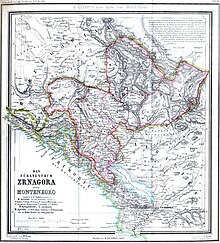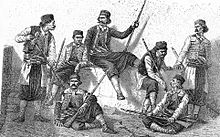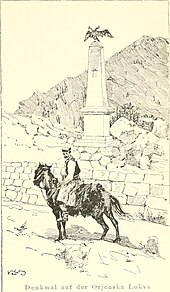Uprising in the Krivošije (1869)

The uprising in the Krivošije ( Serbian Бокељски устанак Krivošijski ustanak ) of 1869 was a successful Montenegrin rebellion against the Landwehr Act of the Imperial and Royal Government of 1868, which restricted the old rights and privileges of the population of the Bay of Kotor. The inhabitants of the highlands of the Krivošije , the western strongly karstified part of the Orjen Mountains, took part in the uprising . The rebels received support from the Bocchese, the inhabitants of the Bay of Kotor . The uprising was ended by the peace treaty of Knežlaz on January 11, 1870, without it being possible to solve the uprising militarily through the military operations of the kk monarchy, which were further intensified in the course of the conflict. The tenacity of the Montenegrins, the imponderability of the Karst terrain and the onset of winter proved to be a hindrance, which, despite the great effort of the main force under Count Karl von Auersperg to Fort Dragalj, an immediate evacuation of the occupied area and the surrender to the Krivošijer insurgents remained a military failure, which forced the government to an early end of the campaign. Between 1500 and 2000 Bocchesen and Krivošijer were involved in the uprising, the center Risan and the highlands lying north of it in Orjen.
Combat area
The main part of the fighting took place on the heavily karstified plateau above Risan up to Dragalj polje. The latter forms a 9 km² measuring area framed by steep mountains without any drainage. The fighting broke out between Fort Dragalj and the mule tracks leading there towards Risan. The rebels used the natural topography of the Krivošije. Between the individual forts to be supplied, large stretches of land were laid out, where the Imperial and Royal troops were ambushed. The insurgents themselves could not be caught in the bushy limestone cliffs by the troops marching in columns.
Prehistory and course
occasion
The uprising sparked in the southeast corner of the kk monarchy in the Kingdom of Dalmatia in the Bay of Kotor . Here, the narrow area of land that formed the area around the Bay of Kotor, while the hinterland were part of the Ottoman Empire or the Principality of Montenegro, favored the fact that the residents felt little affiliation to the monarchy due to the regional remoteness. The introduction of the Landwehr Law passed in 1868 in Dalmatia caused great outrage by the Bocchese (serbo-Croat. Bokelji), whose male residents could now be drafted into military service. The Landwehr Act was to be introduced in all of Dalmatia in October 1869. It was the immediate cause of an armed uprising by the Krivošijer, a Montenegrin clan that settled scattered between Bijela gora and Risan in the east of the Orjen and settled herding animals.
Article III of the new Defense Act had favored the former Ragusa (Dubrovnik) and Cattaro (Kotor) districts: "Conscripts from the former Cattaro district and the mainland of the former Ragusa crisis in the Kingdom of Dalmatia who were previously completely exempt from military service only have conscription in the Landwehr " , they did not have to do any military service with it, but the publication of the law had provoked the indignation of the residents of Kotor for various reasons. In particular, the intention that the Ragusaner and Bocchese should form a joint Landwehr battalion became an unreasonable note for Bocchese. The particularity between Ragusa and Cattaro had expressed itself over the centuries in a stark contrast between the two maritime republics. And finally, the Bocchese were supposed to hand over their weapons themselves, which ran counter to their tradition, as they themselves had asserted their independence from the Ottoman Empire. Even at its zenith, the Ottoman Empire was only able to hold the coastal towns of Castelnuovo (Herceg Novi) and Risano (Risan), but after 1654 withdrew with the exception of an unpopulated strip of land near Sutorina.
The focal point of the uprising was the weak kk fort in Dragalj on the border with Montenegro. The fort in the Polje of Dragalj (Dvrsno) stood east of the Krivošije where the rebels were seated. It was served by a road from Risan via Knezlaz-Crkvic-Han. The road led across it to Grahovo in Montenegro.
The law was published on September 22nd and should take effect on October 6th. The municipalities of Dobrota , Perast and Prčanj first declared that they would not put the young men on the Landwehr lists. The fortress command of Cattaro then threatened to introduce martial law, after which all other communities followed the example of the three communities mentioned. The movement was largely supported by the Serbian Orthodox residents and found support in the priests and community leaders who burned baptismal registers and other registers and physically attacked or expelled members of the commissions for the implementation of the regulations. At the same time, the young men who were required to do so fled to the mountains or to nearby Montenegro. With the formation of Četen of 60 men each, the strategically important positions were filled.
Beginning of the uprising
To the most endangered position in Fort Dragalj with a crew of 32 men, the fortress commander in Cattaro had ordered food and reinforcements. From the Risan station command, 2 officers and 42 soldiers of the 44th Infantry Regiment were to be assigned to Dragalj on October 7th. They were supposed to reach the Polje of Dragalj (Dvrsno) via the shorter path Knežlaz, Ledenica, but had to march through the karst areas in the Kameno more (German: Stone Sea) on the way .
In Ledenice the division was provided by 200 insurgents who demanded that the regiment, with the exception of 5 men, be returned to Risan. The order to fire that the regiment commander then ordered leads to an incident in which an uninvolved person who happened to be carrying his animals there was wounded and triggered a general attack by the insurgents. The regiment could not withstand the attack, it lost a third of its population. The battle of October 7th in Ledenice marked the beginning of the armed conflict. When the news that the armed uprising had started in the Krivošije, it now spread to the Župa and Pastrovići. As a result, the fortress command of Cattaro lost contact with the individual forts.
Another attempt to increase the size of Fort Dragalj ended with the shooting of the two messengers sent by the insurgents, which had finally fueled the anger of the Krivošijer, and the Reich Ministry of War had to impose a state of emergency on the area from then on. The 22nd Infantry Regiment was relocated from Ragusa to Cattaro as reinforcement with immediate effect.
In addition, the 7th, 48th and 52nd infantry regiments stationed in Trieste and the 8th and 9th hunter battalions were ordered to Dalmatia. The navy moves the frigate "Habsburg", several small warships, as well as the gunboats "Kerka" and "Reka" and the steamers "Taurus" and "Lucia" into the bay. On October 13, 1.5 battalions were ordered to Ledenice. With the reinforcement, the connection to the forts Crkvice and Dragalj via Risan should be re-established, and the Krivošije in between should be cleaned up.
The deployment took place on October 19, 1869, the column advanced only slowly due to the nature of the terrain. On October 20th a column had only reached Ledenice, where they were forced to return to Risan after a night battle. A weather change from 19./20. October, with the onset of the bora and stormy rain, surprised the second column near Knežlaz. Due to the adverse weather and terrain, they could only make the way to the Crkvice guardhouse on October 20th. This meant that only a third of the way to Dragalj was covered, but the remainder was even more insidious. As a result, the main column turned back to Risan on the afternoon of October 20th without having achieved anything.
In the Župa, the rebels managed to take Fort Stanjević on October 21 and force his defenders to withdraw. With the increasing intensity of the fighting, it became impossible to relieve Fort Dragalj. The Imperial and Royal regiments had to carry out security measures at two centers of revolt, as the situation around Kotor had also deteriorated. The southern forts of Cattaro, Goražda and Trinità needed reinforcements, and the rebels kept them under fire. After the battles for Trinità, the Bocchese had suffered high losses, which broke the resistance here. From now on, the further fighting concentrated in the uprising in the Krivošije.
The 7th Infantry Regiment had now reached the Bocche from Trieste. This was intended to make a new attempt to reach Dragalj. On October 25, the regiment left Risan. After earlier attempts to penetrate through two routes to Dragalj had failed, only one column was formed. Held up by constant skirmishes with the Krivošijern, the regiment only reached Crkvice in the afternoon with losses. The next morning on October 26th the regiment was supposed to advance to Dragalj via Han. However, the first morning fighting stopped this in Poljana in front of the plain in Dragalj-Polje . During the fighting, the commander was injured and had to give up his command. But the supply and relief of Fort Dragalj had been carried out with great losses.
culmination
Because of the fighting at Dragalj, the uprising had been boosted again. The command of the command in Cattaro was now transferred to Count Gottlieb Auersperg, who was to lead the troops in the further relief to Fort Dragalj. The sluggish course of the operations, which, despite unspeakable complaints for the troops involved and various partial successes, had so far not led to a halfway satisfactory result, began to worry the public in the monarchy. The government began to follow what was going on in southern Dalmatia with growing unease. Thereupon she ordered a change in the management of military operations and called Field Marshal Lieutenant von Wagner back to his post as governor to replace him with Major General Count Gottlieb Auersperg. The public did not justify this change with the previous failures.
On November 7th, the new commander in chief arrived in Budva with Colonel Szimić, who was appointed brigadier. Three days later he ordered the armed forces to be regrouped. One brigade under Colonel Schönfeld - 4 battalions, IV batteries - was to remain in the Župa, the other two brigades under Major General von Dormus and Colonel Szimić - 14 battalions and 5 batteries - were ordered back to Cattaro to take the northern scene of the uprising from there to tackle. After precautions were taken to ensure the security of the connection between Budua and Cattaro, attention turned to the Krivošije, the main focus of the uprising.
For the march, the troops were divided into four columns: the right wing column under Colonel Kaiffel, the V rocket battery - from Orahovac via Ubalac to Ubli, the right middle column under Colonel Fischer from Risano to Ledenice, where it had to unite with the Kaiffel column . The left central column under Colonel Szimić from Risano via Knežlaz to Crkvice. The left wing column under Major Urschitz from Morinje via Ubli also to Crkvice. A total of 10 battalions with 2 mountain and 1 rocket batteries were involved. The final destination of all columns was Fort Dragalj. Two battalions with two mountain batteries under Major General von Dormus were left as reserves in Cattaro.
The four columns began their march on November 16, the right columns united on November 17 at Ledenice, the left columns also on November 17 at Crkvice. After a violent clash near Blagojević, Auersperg thought it advisable to request the reserve from Risan as reinforcement. On the night of November 18, the available troops remaining in Risano were sent on their way to Crkvice. On November 18, the attack by 4th companies of the 44th regiment ended with a disaster and a retreat. The regiments involved had lost more than a quarter of their rank: 4 officers and 22 men dead, 4 officers and 30 men wounded.
Auersperg's headquarters was itself the target of a night attack on November 19 when it was encamped in the Polje of Dragalj. The insurgents even almost succeeded in taking the headquarters. Only the relief from Fort Dragalj prevented this. Some of the mules and provisions were left behind. After Auersperg arrived with troops at Fort Dragalj, it was recognized, in view of the onset of winter weather and the lack of accommodation, that a permanent position could not be established. On the same day the troops were ordered to withdraw. After Auersperg was back in Risan that evening, the troops followed him on November 23rd. As they marched back, they faced constant attacks. With disproportionate casualties, 14 dead, several missing, and 40 wounded, the retreat turned into an ordeal in which the troops made slow progress in pouring rain and difficult ground conditions.
Result
The lack of tangible success and the emergence of the incidents worried and embittered the public in the monarchy. The dissatisfaction with the government became all the more pronounced when it tried to gloss over the ineffectiveness of the military operations. The displeasure also became more and more evident in the daily press, which demanded an early end to the uprising. The government was extremely embarrassed that the operations went unworthy of a great power, and they also had to bear high material costs. With the armed forces available, a quick victory had apparently not been possible, but greater effort was not a realistic consideration. In addition, the onset of winter had proven too great an obstacle for military operations in such difficult terrain.
After the fighting was over, the imperial and royal monarchy fortified the borderline with numerous forts that stretched from Trebinje to Budva in a cordon. Emperor Franz Joseph I visited the forts in Knežlaz, Crkvice and Dragalj on his trip to Dalmatia in May 1875, coming via Risan. On May 8th, 1875 he arrived at Fort Dragalj, which was now more secured by a high wall and a fortified gate than at the time of the uprising.
reception

The uprising is an important reception point for national self-assertion by the Montenegrin population. The Montenegrin poet Radovan Bećirović Trebješki wrote an epic composed in Trochaic meter for the accompaniment with the gusle.
Krivošijska buna 1869
…
Чујеш Грбаљ и Маине јече
Рекао би Орјен да лелече.
Вуци вију као да се жале
Да су им се звјерке разбјежале.
Ауесперг и друштво цијело
У Дворничко заглави ждријело,
Не даше им устаници проћи
Нападоше ћи ох уих уше ћи.
Велику им војску поломише,
Сву опрему ратну заробише.
Ту погибе двадес 'официра
Свакога би по јунаштву бира,
Сам ђенерал утече са штабом,
…
The uprising of the Krivošije in 1869
…
Do you hear Grbalj and Maine crying
And I say Orjen moans
The wolves howl as if they are mourning
That all monsters have escaped from them.
Auersperg and his entire
entourage were trapped in the Dvrornicko zdrijelo,
the rebels held them there
and attacked at midnight.
They defeated a great army, and
all their military equipment went as booty.
Twenty officers died there,
each chosen for his courage.
Only the general fled with his staff.
...
swell
- Austrian State Archives - War Archives, Vienna
Individual evidence
- ↑ Tomislav GRGUREVIĆ: CRNA GORA I BOKELJSKI USTANAK 1869. GODINE
- ^ The uprising in southern Dalmatia ". War chronicle of Austria-Ungams, communications from the kuk war archives. Vienna 1892
- ^ Notices from the kuk war archive. Supplement (1892). War Chronicle of Austria-Hungary. Military leader in the theaters of war of the monarchy. III. Part. The southeastern theater of war in the countries of the Hungarian crown, in Dalmatia and Bosnia
- ^ Album of the Imperial Journey through Dalmatia, 1875 Description Views from: top left: Dragal, bottom left: Zdrjelo, top right: Kneslaz, bottom right: Crkvice. Original photos of the Androvic-Goldstein corporation, studio dating May 7th, 1875
- ↑ Arrival of Emperor F. Josef I on May 6, 1875 in Risano
- ^ Arrival of Emperor Franz Josef I in Dragalj on May 8, 1875
- ↑ Krivosijska buna 1869





